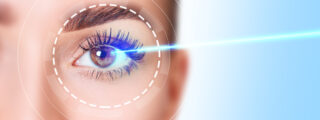
Vision 101: Blue Light and Digital Eyestrain
GOT THE BLUES?
What you need to tell patients about indoor exposure to blue light, and why it’s so important to address these issues with both you and their family members.
Tip: “Nine out of 10 patients never bring up digital eyestrain with you, so be sure you initiate that all-important conversation.”
More than six out of 10 Americans report experiencing digital eyestrain. That is, dry, irritated eyes, blurred vision, eye fatigue, headaches, and pain in the back and neck.
Multiply that by the fact that 70% of Americans use two or more devices at the same time, with more than half of all users spending five hours a day or more on them.
THREE PROBLEMS
There are multiple problems associated with this ever-increasing usage of devices and other exposure to blue light.
- One is obviously eyestrain.
- A second is the fact that nine out of 10 patients report they don’t ever address their use of digital devices, or problems stemming from them, with their eyecare professional.
- And the third, and the most dangerous impact of heavy digital device usage, are the long-term problems associated with exposure to high-energy visible (HEV) or blue light from these devices, as well as from other sources inside the home, store, and office.
LONG-TERM IMPACT
Most patients have no idea that ongoing exposure to screens and the resulting exposure to backlit displays and other blue-light sources are increasingly showing links to long-term problems like age-related macular degeneration and cataracts.
FOUR FACTS
Here are four facts you can share with patients. For more information on this important subject, check out The Vision Council’s 2016 Digital Eye Strain Report at www.thevisioncouncil.org.
- LED. All digital devices, fluorescent lighting, and many appliances have light-emitting diodes or LED, which are known to emit blue wavelength light that, long-term, is being shown to damage retinal cells.
- INTENSITY. Blue light penetrates more deeply into the eye than UV light, so, according to The Vision Council report, “exposure may damage the retina by exposing the eye to hidden spikes in intensity.”
- SLEEP. While this high-energy light is important in terms of cognitive functions like memory, regulating emotions, and increasing alertness, it can also interfere with sleep by decreasing the release of melatonin. That can result in disruption of sleep patterns because the of increased alertness.
- CONCENTRATION. Stanford University research suggests that individuals “who are regularly bombarded with several streams of electronic information cannot pay attention, recall information, or transition from one project to another as well as those who complete one task at a time.”
How do you explain effects like these of indoor blue-light exposure to your patients? Tell us and share in the conversation on Facebook here.
Comments are closed.







